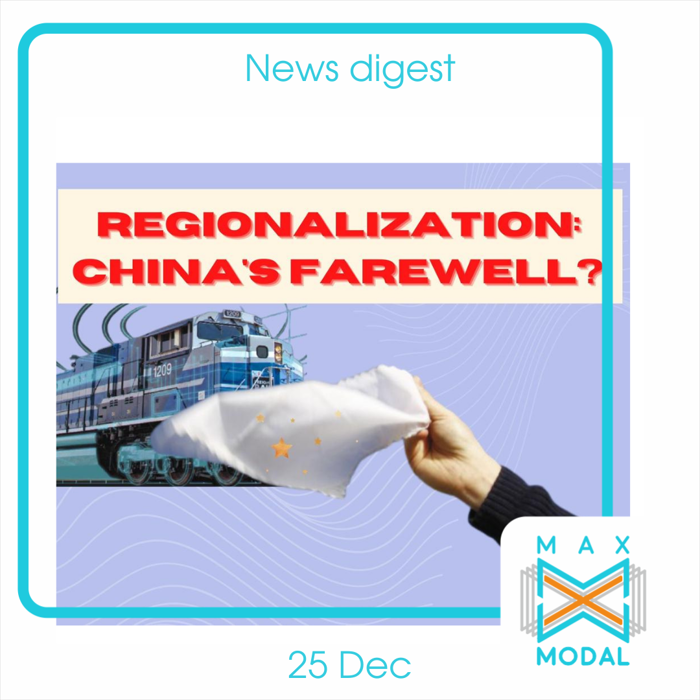News digest. 25 Dec
With China becoming less favorable, does it mean it is time to wave it with a handkerchief? It seems like it is Eastern Europe’s moment to shine.
Reconsideration of suppliers has been in the talks for months since the costs started to rise. Initially, China was everyone’s favorite since sourcing from there used to be indeed the most efficient way. However, the rules have changed and the new reality requires new approaches. Many European players are planning to expand to Eastern Europe in 2022. What are the benefits? Sourcing from there or Mediterranean countries significantly cuts lead times when those from Asia to Europe have almost doubled due to supply chain disruption. At the same time, in the US, everyone is switching focus to Latin America, so near-shoring is set to become a global phenomenon that we are most luckily to start the new year with. However, it does not mean that Asia is forgotten – Maersk has sealed the deal of a $3.6bn acquisition of Hong Kong-based LF Logistics. The move is taking the giant further down its avowed corporate path to becoming a logistics integrator. Although Maersk’s “buying spree” has boosted the company’s assets greatly, it has still lost to MSC in the race of becoming the biggest line. The latter has “checkmated” Maersk thanks to the acquisition of 67% of Log-In – Logistica Intermodal S.A, a Brazilian company. With the new balance of power, what will be the next battleground for competition?
No matter the potential redirection of universal focus to Eastern Europe, the China-Europe rail direction remains exceptionally busy. Having transported 436,632 TEU so far, the market has set a new record. This is why new services are of great importance. The most recent one is the launch from Guangzhou on the southeast coast of China, to the main port of Germany: Hamburg. As congestion remains a pressing issue, rail becomes a sufficient alternative for cargo transportation. China senses the new direction of the wind and hurries to strengthen its presence in Eastern Europe too by introducing the train to the Polish harbor of Gdynia. After all, nobody has expected the country to ease its clawed grip off the region. However, not everything is so smooth. One of the biggest concerns regarding the New Silk Road includes the launch of regular chemical trains because there is no standardized approach to this segment of the industry. In addition, it is the notorious congestion that puts this initiative out of scope. At the same time, the Middle East is not slowing down and the Islamabad-Tehran-Istanbul railway train has finally seen the light. The corridor has great potential and more players such as India and Bangladesh are considering joining it in order to realize a faster transport link to Europe. Besides, the new train is eco-friendly, which aligns with the standards of the new sustainable agenda. Can the rail really take the congestion blast solely on itself? Is there a capacity for it? The US hopes so. As experts report no significant improvement at the Ports of LA and Long Beach reporting historical highs, the authorities switch to rail and give the Port of Long Beach a grant of $52.3 million for development. The rail capital improvement program aims to utilize moving more cargo by on-dock rail as it is cleaner, more efficient, and reduces truck traffic. The construction of the new facility will begin in 2023 and is planned to finish by 2032. Otherwise, the Port will not be able to handle all the incoming TEU. The elevated throughput concern Europe too where the volumes in the Port of Rotterdam surpass 15 million TEU. The problem lies in the fact that the ports all over the world are not growing fast enough and this cannot address the skyrocketing demand. As the result, lines continue deteriorating their calls to avoid further delays. For now, the authorities will continue to emphasize and encourage the importance of digitization, cooperation and data sharing to provide a better response to the global pressure on the logistics chain – now and in the future. What also adds up to piling issues is the post-Brexit policies that many have appeared unprepared for, thus local governments will be forced into unfavorable policies.
Not only ocean freight is extraordinarily expensive. Airfreight spot rates have been surprising shippers for weeks, and although the market has seen a small decline recently (the figures from China to the US have dropped to $13.82/kg), no one is really hopeful that it will last especially when there is a threat of lockdown in Europe lingering in the air. If they are imposed, consumer spending is expected to increase which will put more pressure on supply chains. Logically, companies are already bracing up and start expanding their assets. In the case of UPS, the company has made a major freight order from Boeing, which has broken its record in freight sales this year. Singapore Airlines follows suit and makes a similar strategic move by teaming up with Airbus to purchase freighter aircraft. It will burn up to 40% less fuel on similar missions to provide better operating economics, and boasts a longer range that offers greater flexibility in aircraft deployment.

